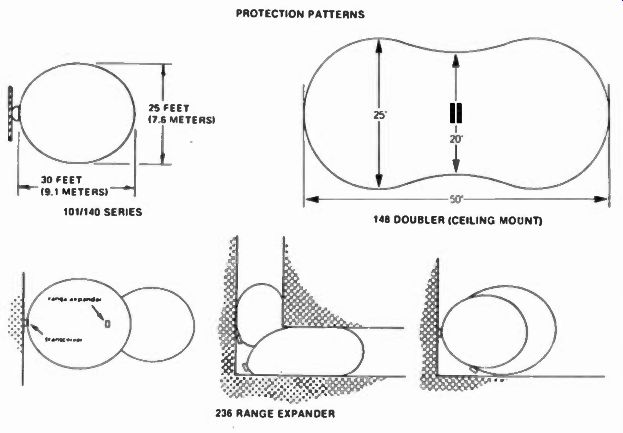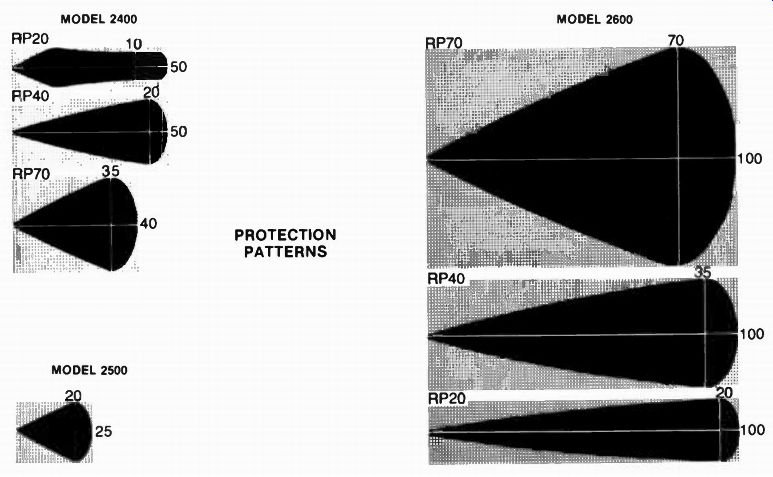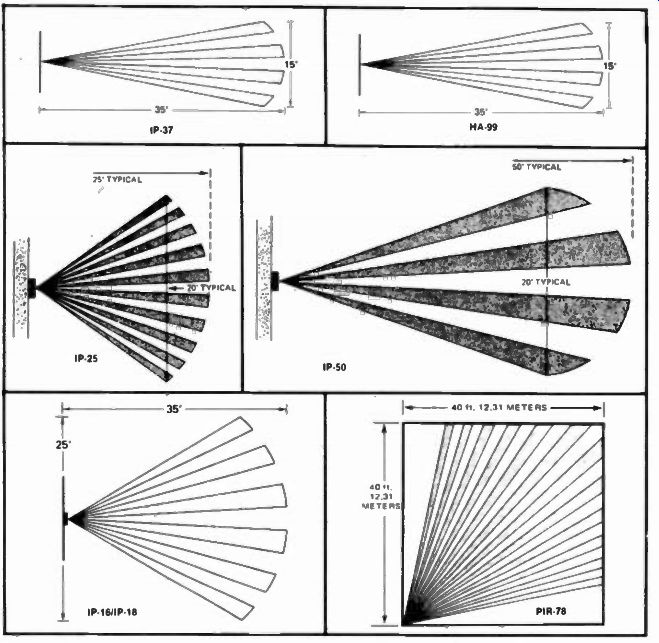The four popular types
When installing area protection devices, you have a choice of four common types of detectors each of which has advantages and disadvantages. Here are some of the factors to consider.
by George Kanelos [of the William B. Allen Supply Co., Inc., New Orleans.]
Each of the four common types of space intrusion detectors, photoelectric, ultrasonic, microwave, and passive infrared has its own requirements for effective installation.
When considering the selection of equipment for an installation, first consider where space protection fits into the overall system. How many areas must be protected? Will space protection be the primary or secondary form of protection? How large is each area, and what is its shape? Where are the points of entry? What objects will obstruct the sound path? Is the environment "hard" or "soft"? What hazards exist, such as air vents, fans, blowers, hanging objects, sources of noise? Is remote control required? Individual area alarm memory or remote area annunciation?
Photoelectric Detectors
Photoelectric intrusion detectors are among the oldest and most commonly used space protection devices. When properly installed, photoelectrics reliably provide either localized "trap" or long range area protection. They assume one of two general configurations: the conventional two piece transmitter/receiver system, consisting of separate transmitting (sending) and receiving (monitoring) units or the one piece self-contained transceiver, housing both its transmitting and receiving components in one package.

Fig. 1. Typical ultrasonic detector coverage patterns. (Courtesy AR/TECH)

Fig.
2. Microwave intrusion detector coverage patterns. (Courtesy Solfan)
Photoelectric systems detect intrusion when an invisible beam, usually a pulse-modulated infrared signal, sent by the transmitter and monitored by the receiver is interrupted by an intruder passing between the two. A relay, located in the receiver and wired into the protective circuit of an armed burglar alarm system activates the alarm.
Photoelectrics are available for surface or recess mounting, in plastic or steel enclosures and for indoor or outdoor applications. Depending on the photoelectric selected, effective range of up to 1000 feet are possible, making these units suitable for an extensive variety of applications.
Installation is relatively uncomplicated, requiring only the simple alignment of the beam passing between the transmitter and receiver or the transceiver and a reflector, after the units have been mounted in the desired locations. Inexpensive installation aids to further simplify beam alignment are readily available.
Available in some systems is a unique extension of the photoelectric's versatility which allows a protective loop *o be powered by the transmitter component of the system. Wired directly to the transmitter, an open or short in this loop will cause the transmitter's light source to turn off and simultaneously activate the receiver to signal an alarm condition to the main control just as if someone had walked through the beam. The transmitter has become, in effect, a circuit receiving device allowing additional openings to be protected without additional wire runs back to the nain control.
Common applications for photoelectric systems include hallways, aisles, banks of windows, stairways and heavily trafficked areas for control purposes. For indoor applications, special mirrors are available to make bends around corners and inexpensively increase coverage.
Outdoor photoelectronics, specially designed to shut down in the event of severe fog, snow or sleet and containing thermostatically controlled heaters to prevent condensation are ideally suited for short or long range (up to 500 feet) perimeter protection.
A fenced area with a clear field of view between the transmitter and receiver is all that is required for reliable and relatively inexpensive protection.
Today, the photoelectric remains one of the most dependable and cost effective protective devices available to the security industry. Its versatility and long history of reliability make its consideration almost mandatory when space protection is required.
Ultrasonic Detectors
Ultrasonic waves are sound at a frequency above the normal 15,000 to 20,000 Hz limit of human hearing.
They can be used to provide economical and effective indoor intrusion detection.
The phenomenon known as the "Doppler Effect" provides the operating principle of all ultrasonic detection systems. It can be explained by means of an example: A jet plane flying at a low altitude over an observer will seem, to the observer, to make a high pitched whine as it approaches and a low pitched roar after it passes. While the plane is approaching, the frequency of the sound that reaches the observer's ears is a result of the plane's actual engine sound plus the speed at which it is approaching. After the plane passes, the observer hears the lower frequency, a net result of the plane's actual engine sound minus the speed of the departing plane. This apparent change in frequency is called the "Doppler Shift." Otherwise stated: If the source and the observer are standing still, then the frequency the observer hears is equal to that coming from the source.
If either the source or the observer moves toward each other, the frequency reaching the observer increases. When they move apart, the frequency decreases.

Fig. 3. Passive infrared intrusion detector patterns. (Courtesy Colorado Electro-Optics).
Ultrasonic intrusion detectors utilize the Doppler Effect to perceive motion in a protected space. One or more ultrasonic sources fill the area with ultrasonic waves. These bounce off walls, ceiling, floor and other stationary objects in the area and ultimately reach one or more pick-up devices at the same frequency that was transmitted from the source. In addition ultrasonics bouncing off a moving object (such as an intruder) will generate frequencies that are slightly higher or lower than the source's frequency. These Doppler shifted frequencies will also be picked up by the ultrasonic system's receiving transducers. The system is designed to ignore the frequency that is provided by the transmitting transducers, but will initiate an alarm signal upon receipt of "Doppler shifted" frequencies.
A transmitting transducer is a device that converts electrical energy to sound energy. A receiving transducer is a device that converts sound energy to electrical energy.
Conventional speakers and microphones are examples of transducers but the transducers used for ultrasonic intrusion detection are specifically designed for this purpose.
A transceiver is, of course, a single unit containing a transmitting transducer and receiving transducer.
Ultrasonic layout and performance considerations:
1) Choice of Transceivers vs. Individual Transducers: Transceivers provide excellent spot coverage where wiring convenience must be considered but where uniform coverage over a wide area is not a prime requirement. Individual transducers can provide more uniform coverage and sensitivity over an area than transceivers can provide, but generally require more wiring.
2) Coverage Pattern and Aiming of Transducers: A wide selection of transceivers and transducers with narrow, wide and omni-directional coverage patterns are available. Most can be aimed to provide additional versatility.
3) Room Acoustics: Placement and aiming of the transceivers or transducers in relation to the walls, ceiling and floor of the area influence the system's performance as do the type of surfaces (Hard, smooth reflective surfaces are best) and the presence of sound absorbing materials such as furniture, carpeting and draperies (which reduce coverage).
4) Disturbances: Air Turbulence (from drafts, space heaters, air conditioning vents, rising heat from radiators, etc.), Sources of Ultrasonic Noise (such as telephone bells, hissing steam, leaking compressed air, whistles, etc.) and Vibration (from machinery, loose fitting doors and show windows or walls that shake when the wind blows or traffic passes) all are serious sources of disturbance in improperly designed systems. A properly designed system, however, will reduce or eliminate the effect of such disturbances in a variety of ways.
5) Humidity and Temperature: Ultrasonic waves are affected by atmospheric humidity and temperature. Between the best and worst combinations of conditions, range can change over 50%. this can be taken into account during installation and adjustment of the system.
Microwave Detectors
Microwave intrusion detectors also operate on the Doppler Effect. They are available in self-contained and multi-head configurations and provide a wide range of protection patterns from 25 feet to 300 feet, and function by projecting these precise, high frequency (10.525 GHz) radiation patterns into protected area. A moving intruder, interrupting a protection pattern will cause a shift in its frequency. This Doppler frequency shift is immediately sensed by the detector and electronically converted into an alarm signal.
Microwave detectors feature adjustable range controls which allow the size of the protection pattern to be varied according to the need and interchangeable antennas which permit selection of the most effective radiation pattern for a given application. They are virtually immune to false alarms caused by changes in temperature, humidity or high frequency noise created by bells, sirens, air compressors, etc. They can be successfully installed where air currents from heaters, air conditioners or breezes exist and are ideal for use in large open areas and long hallways. To insure a trouble free system, there are four precautions which should be observed before and during installation:
1) Microwave protection patterns can penetrate into undesired areas.
This penetration can result in the detection of movement outside of a protected area and subsequent false alarming. The degree of unwanted penetration is determined by the material being penetrated: To prevent unwanted penetration, the composition of wall materials bordering the protected area should be determined and microwave detectors selected with detection patterns providing minimal or no penetration.
2) Stationary metal objects reflect microwave energy aimed at them. Although, reflection can sometimes increase protection by intensifying the coverage in a given area, reflected microwave energy should not be directed at a window through which it can penetrate or at an occupied area where movement can cause false alarming.
Material Degree of Penetration Glass 100%
Dry Wall 50%
Cinder Block 10%
Metal none
3) Target size and reflectivity are critical considerations when placing microwave detectors. A target is defined as an object at which the microwave detector is aimed and which consequently reflects microwave energy. One of the most common causes of microwave false alarming is a detector aimed at a metallic or other large object which moves during the protection period.
The target may even be located well outside the rated range of the detector and still create a problem. An example of this phenomenon is a 50 foot detector aimed at an overhead door located 100 feet away. If the door rattles significantly from wind or other causes, the detector may trip. This happens because a 50 foot detector is rated to sense a man taking two steps at a distance of 50 feet. Man, however, is composed predominantly of water, a moderate reflector of microwave energy and approximately equivalent in reflectivity to a six inch square piece of metal equidistant from the detector. Thus, a rattling door, because of its size and reflectivity, may be sensed at distances greater than the detector's rated range.
Again, as in the cases of penetration and reflection, observation and testing are invaluable tools in isolating and correcting problems associated with target size and reflectivity.
4) Vibration of the area in which a detector is mounted, caused by passing trains, traffic, compressors, etc., can be interpreted by the detector as the movement of a large object and result in false alarming.
Vibration problems can usually be eliminated by securely mounting detectors, using vibration absorbing mounting materials when necessary and aiming detectors away from items which can be set into motion by building vibrations.
It is evident that microwave detection, like other recognized types of space protection, requires a basic conceptual understanding and careful planning. However, when properly applied and installed, microwave provides a dependable, cost effective and extremely stable level of protection. The simple precautions discussed above should not deter the use of microwave detection. Rather, as is the case with all space protection equipment, they should be carefully followed to insure a trouble free installation.
Passive Infrared Detectors
Although the use of passive infrared technology is relatively new as a detection medium, the phenomenon of infrared or "invisible light" has been understood and successfully employed in a variety of other applications for many years. Infrared, not visible to the naked eye, is transmitted in a long wave length and generated or radiated at different levels by every object, whether animate or inanimate, warm or cold, as a function of the object's temperature. Recognizing that all objects radiate infrared energy, the ability to measure small, rapid changes in the level of that energy, created by the movement of an object into a specific area, has resulted in the development of one of the most stable and reliable of all space protection devices, the passive infrared detector. The passive infrared detector, viewing a specific area, establishes a normal condition which is actually the infrared radiation level generated by all of the objects in that area. A lens or mirror system is used to focus the thermal images of the objects on the detector's sensor element. When an intruder enters the viewing pattern of the detector, his thermal image is also formed on the detector's sensor element, indicating a change in the normal condition and initiating an alarm.
Passive infrared detection offers four important advantages to the installer considering space protection:
1) Since passive infrared detection, as its name implies, does not transmit energy of any kind, interference between units in multi-detector installations is eliminated as is any potential safety hazard to humans or pets.
2) Passive infrared cannot "see" through glass or walls, and any physical barrier will stop the protection pattern. Thus, with proper installation, false alarms commonly caused by "creeping" or penetration are eliminated.
3) Because passive infrared detection uses an adjustable optical system, the protection pattern is extremely controllable, permitting small pets to enter a protected area without causing false alarms.
4) Passive infrared detectors do not "see" air and will not false alarm because of warm or cool moving air.
To help insure a trouble free installation, avoid installation of a detector facing exterior windows or where direct sunlight can strike the face of the unit. Do not install a detector where items which heat or cool rapidly such as radiators, electric motors or heating or cooling vents are in its field of view. Although gradual room temperature changes have no effect on the detector, direct sunlight striking its face or rapidly heating or cooling objects directly in its field of view may cause false alarms. The operating temperature range of passive infrared detectors is generally between 0°F to 135°F. Ideal detection situations occur where room temperature is below 85°F or above 100°F. Depending on the detector, its field of view will be divided into a minimum of four to a maximum of sixteen zones. Each zone will be viewing and monitoring a specific segment of the protected area and substantially reducing the possibility of an intruder remaining undetected.
Passive infrared, with its many advantages, range of detection patterns, mounting flexibility, installation ease and only minor limitations represents an affordable and reliable solution to many space protection problems. It can be used with confidence by even the novice installer.
To come
This has been a quick rundown on the principles and uses of the major types of intrusion detectors. ET/D hopes to have technical details of the circuitry and operation of each in the near future.
(source: Electronic Technician/Dealer)
Also see: Alarm Installation -- Basics